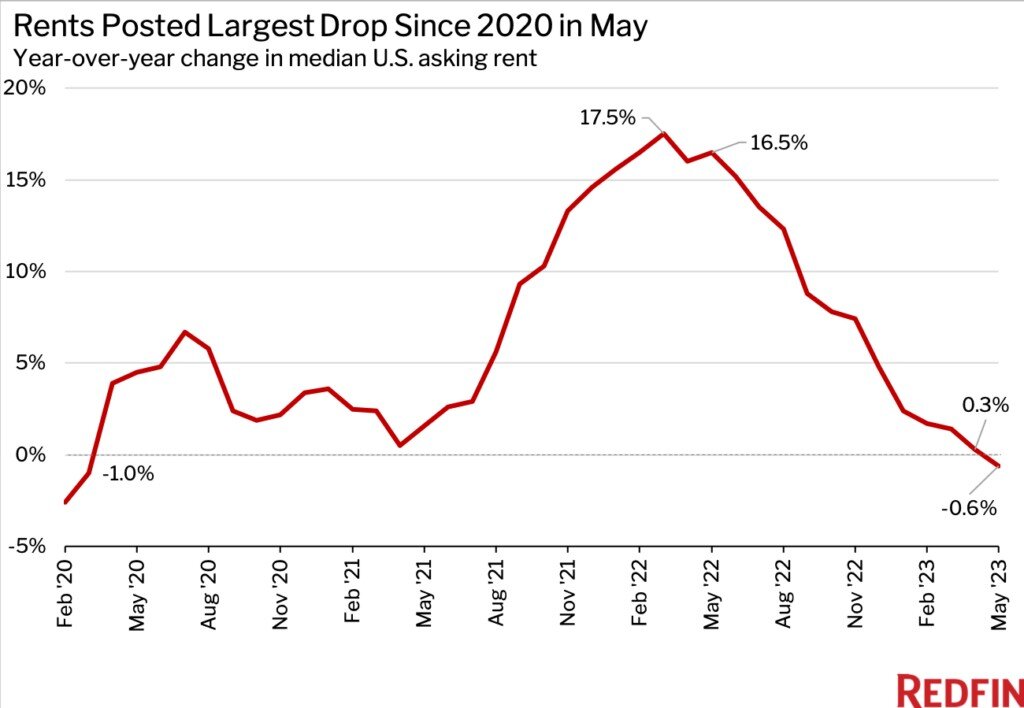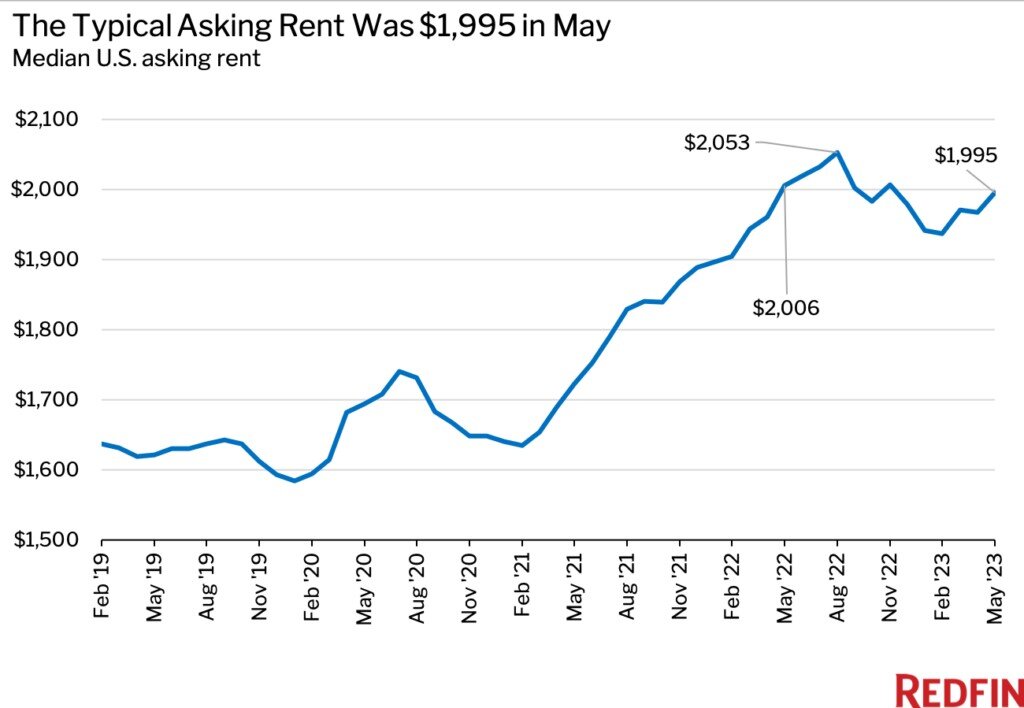Residential Real Estate News

Home Asking Rents Dip in the West, Yet Rise in Eastern U.S.
Residential News » San Francisco Edition | By David Barley | June 13, 2023 9:34 AM ET
According to Redfin, the median U.S. asking rent fell 0.6% year over year to $1,995 in May 2023 -- the largest annual rent decline since March 2020. That compares with a near-record 16.5% increase one year earlier. May's drop also represented the first annual decline since March 2020 on a revised basis. The median asking rent rose 1.4% from a month earlier in May.
In the West, asking rents declined 2.1% from a year earlier--nearly four times the national pace. But other U.S. regions saw increases, with rents climbing 5.4% in the Northeast, 4.9% in the Midwest and 0.8% in the South.
Rents have cooled in part because the number of rentals on the market has grown, giving landlords less leeway to hike prices because they're grappling with a rise in vacancies as renters get more options to choose from.
One reason rental supply has been growing is many homeowners are opting to rent their homes out instead of selling. Some have already moved into their next home, and are renting their previous home out to cash in on still-high rents and continue building equity on a house with a relatively low mortgage payment. The average 30-year-fixed mortgage rate is 6.8%, up from 5.09% a year ago and a record low of 2.65% in January 2021. The average monthly payment is $320 higher than it was at this time last year.
"Many homeowners are deciding that instead of selling, they're going to renovate their current home or rent it out while they wait for the market to improve," said David Orr, a Redfin Premier real estate agent in Sacramento, CA. Some homeowners are likely waiting for housing prices to bounce back so they can make a larger profit when they do sell.
Rental supply has also increased because America has been building more multifamily housing. Completed residential projects in buildings with five or more units rose 24.2% year over year on a seasonally-adjusted basis to 400,000 in April--the most recent month for which data is available. This is likely part of the reason the rental vacancy rate has ticked up; it was 6.4% in the first quarter--the highest level in two years.
While a building boom has driven up the number of rentals on the market, the boom is slowing. The number of permitted residential projects in buildings with five or more units fell 22.9% year over year on a seasonally-adjusted basis to 503,000 in April. Permits, or approvals given by local jurisdictions to start construction projects, are a leading indicator of what's happening in the housing market. Completions are a lagging indicator. Still, there remains a backlog of under-construction rentals that have yet to hit the market, meaning rents likely still have room to fall.
Finally, rents have eased because fewer people are moving due to economic uncertainty, slowing household formation, still-high rental prices in many markets, and the rising cost of other goods and services due to inflation.
While asking rents fell from a year earlier in May, they were still only 2.8% below their August peak of $2,053, meaning many renters are still taking on high rents. That isn't the case in every market, though; in areas where rents are cooling more, renters are more likely to get deals and concessions from landlords.
Rents Are Falling in the West, Rising in the Northeast
In the West, the median asking rent fell 2.1% year over year to $2,409 in May. That's the only region Redfin analyzed that saw an annual decline. Asking rents rose 5.4% to $2,495 in the Northeast, 4.9% to $1,406 in the Midwest and 0.8% to $1,663 in the South.
Rents are cooling fastest in the West and South in part because they rose so much during the pandemic as scores of people moved into places including Phoenix and Miami. Now, rents in those regions have relatively more room to fall as supply catches up with demand. Rent growth has been steadier in the Midwest, which is home to many relatively affordable markets.
The West is also seeing rents decelerate quickly because it is building a lot of multifamily housing, which means landlords in some areas are grappling with rising vacancies. There were 440,000 new non single family homes completed in the West in the first quarter, compared with roughly 200,000 in each of the other three U.S. regions. Expensive West Coast tech hubs like Seattle and San Francisco may also be experiencing rent declines due to remote work and tech layoffs.
Sign Up Free | The WPJ Weekly Newsletter
Relevant real estate news.
Actionable market intelligence.
Right to your inbox every week.
Real Estate Listings Showcase
Related News Stories
Residential Real Estate Headlines
- U.S. New-Home Sales Surge in August as Mortgage Rates Ease
- Despite Increased Foreign Buyer Activity, Miami Residential Sales Dip 11 Percent in August
- California Home Sales Enjoy Modest Uptick as Mortgage Rates Ease
- U.S. Home-Flipping Profits Sink to Lowest Level Since 2008 Financial Crisis as Costs Climb
- Why the World's Rich Are Flocking to Europe in 2025
- Federal Reserve Delivers First Rate Cut of 2025 as Mortgage Relief Proves Limited
- Homebuilder Sentiment Holds Steady in U.S. as Rate-Cut Bets Lift Outlook
- U.S. Mortgage Rates Experience Sharpest Weekly Drop in Over a Year
- U.S. Foreclosures Rise for Sixth Straight Month as Affordability Pressures Mount
- Black U.S. Homeownership Rate Falls to Two-Year Low as Job Losses Mount
- Las Vegas Home Prices Flatten as Listings Surge, Sales Slow
- Cooling Miami Housing Market Sees 16 Percent Annual Sales Drop in July
- U.S. Mortgage Delinquencies Uptick in June Amid Regional Pressures
- California, Florida Top U.S. Housing Markets Most at Risk of Downturn
- 30-Year Mortgage Drops to 6.56 Percent in Late August, Lowest Since October 2024
- Investors Maintain Elevated Role in U.S. Housing Market Despite Slight Pullback
- Pending Home Sales Show Mixed Signals as U.S. Buyers Remain Cautious
- Canadian Home Sales Extend Recovery in July
- U.S. Home Sales Rise in July as Buyers Gain More Bargaining Power
- Zombie Foreclosures Edge Up Across U.S.
- 2.6 Million Homes at Wildfire Risk Across 14 Western States in 2025
- One in Five Americans Willing to Trade Personal Safety for Home Affordability
- U.S. Home Price Growth Slows as Affordability Pressures Mount in 2025
- U.S. Mortgage Rates Dip to Four Month Low in Early August
- U.S. Mortgage Applications Rise in Late July, Breaking Four-Week Slump
- Hong Kong's Housing Market Stuck in Stalemate as Bulls and Bears Face Off
- U.S. Condo Market Struggles in 2025
- U.S. Pending Home Sales Remain Sluggish in June
- Los Angeles Area Wildfires Destroyed Nearly $52 Billion in Homes Last January
- Greater Palm Beach Area Residential Sales Slip in June Amid Growing Inventory
- Economic Resilience Lifts U.S. Housing Outlook Going Forward
- New Home Sales Stagnate as Affordability Struggles Continue in America
- U.S. Housing Market Slips in June as Prices Hit New Highs
- Florida, California Continue to Reign Supreme as America's Ultraluxury Housing Markets
- Caribbean Housing Market Evolves into Global Second-Home Hotspot
- U.S. Home Sales See Highest June Cancellation Rate on Record
- Orlando Housing Market Cools in June as Listings Slide, Sales Slow
- Private Credit Surges in 2025 as Real Estate Developers Bypass Banks
- U.S. Condo Market Suffers Sharpest Price Drops in Over a Decade as Buyers Retreat
- Rising Taxes, Insurance Costs Undermine the Stability of U.S. Homeownership









